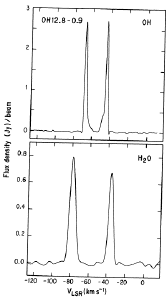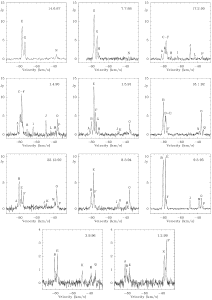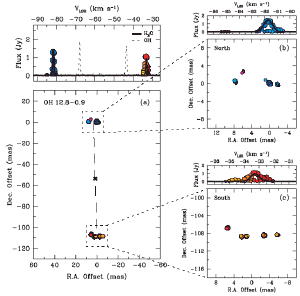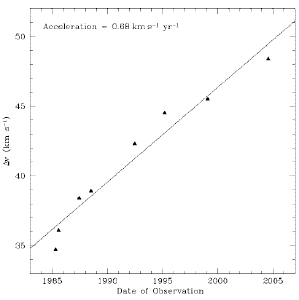|
IRAS 18139-1816 -- a water
fountain star.
 | VLA and Heystack Observatory single dish observations of OH and H2O masers in IRAS
18139-1816 showed a larger expansion H2O maser velocity than OH
maser, indicating a water fountain star. (from Gomez et al.,
1994RMxAA..28...97G)
(figure: LVA spectra of OH and H2O
masers during 1991-1992)
 |
 | Monitoring of the 22GHz H2O masers in 4 non-variable OH/IR stars showed stable gross spetral structure with varying
features. Life time of individual maser features is 1-3
yrs. These behaviors are quite different from ordinary OH/IR stars, which
allows identification of PPNs by maser observations. The H2O masers of two sources,
IRAS 18135-1456 (OH
15.7+0.8) and IRAS 18276-1431 (OH 17.7-2.0), continued to weaken and disappeared in the end. The H2O masers of the other two sources,
IRAS18139-1816 (OH
12.8-0.9) and IRAS 18596+0315 (OH 37.1-0.8), showed acceleration of outflow velocity (with current l.o.s. Vexp = 28 and 28.5 km/s
respectively). (from Engels, 2002A&A...388..252E)
(figure: OH maser spectral variation
for IRAS18139-1816)
 |
 | IRAS 18139-1816 is the fourth water fountain
source. VLBA observations of H2O and OH 1612, 1667 MHz masers are presented. The H2O maser
spot are separated in two groups with separation of ~109 mas.
In smaller scale, H2O maser spots distribute in two arctuate regions
of ~10-12 mas across, tracing bow shock fronts.
The distance is unknown (may be ~ 8 kpc). The source position 18h16m49.23s; -18d15m01.8s (J2000) was used. The
velocity separations are dV(OH) = 24.4 km/s, dv(H2O) = 48.4 km/s. Vlsr = -56.6 km/s (average if OH and H2O masers). H2O masers
are being accelerated at 0.68+-0.06 km/s/yr (from spectral range
variations) and the H2O maser dynamical age is
about 71~109 yr (under some assumptions). (above from Boboltz and Marvel,
2005ApJ...627L..45B)
(figure: left -- the spectra of OH
and H2O masers and the spatial map of H2O maser spots; right -- increase of H2O
maser velocity separation with time.)
 
|
|
![]()